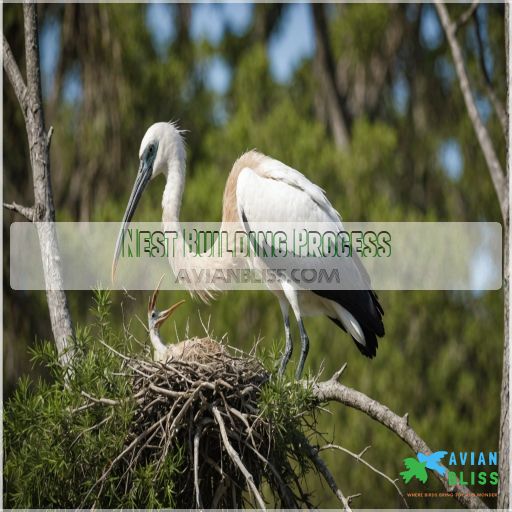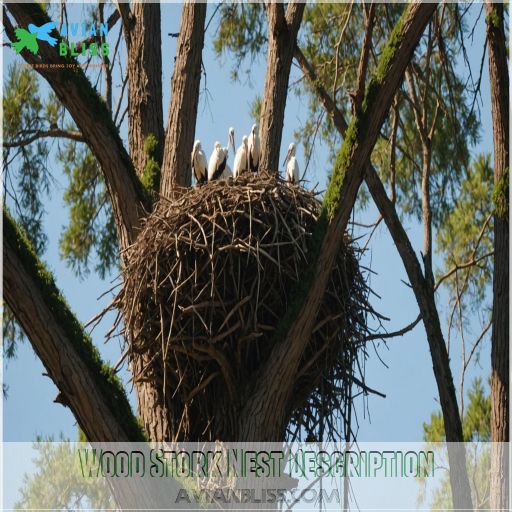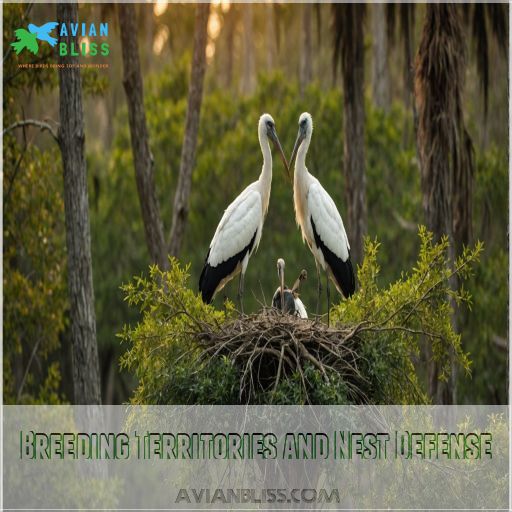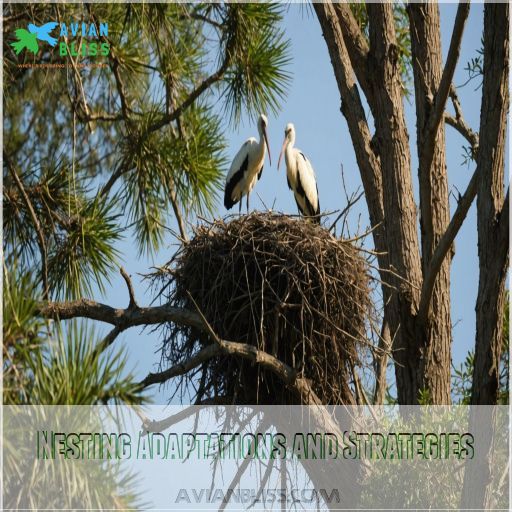This site is supported by our readers. We may earn a commission, at no cost to you, if you purchase through links.
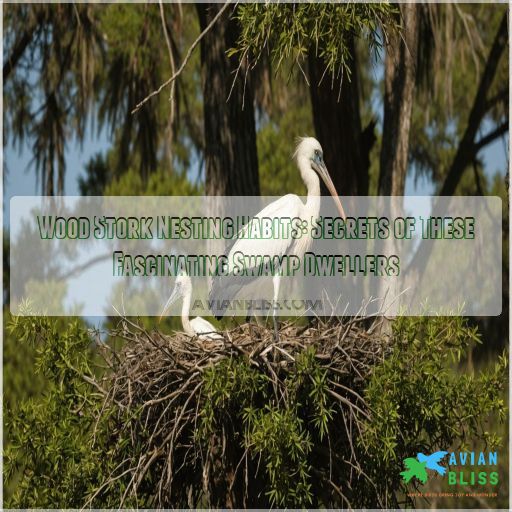 Wood stork nesting habits are a marvel of nature.
Wood stork nesting habits are a marvel of nature.
These lanky birds are picky real estate agents, choosing wetlands with tall trees near water. They’re social creatures, building nests in bustling colonies that can house hundreds of feathered families.
You’ll find their stick-and-moss mansions perched 3 to 50 feet high, usually over standing water. Both parents pitch in to construct and maintain these 20-25 inch wide nurseries.
The whole process is a bit like extreme home makeover, bird edition! Incubation‘s a team effort too, lasting about a month.
But it’s not all smooth in stork-ville – these nesters face some serious challenges. Curious about how they overcome them?
Table Of Contents
- Key Takeaways
- Wood Stork Nesting Grounds
- Nest Building Process
- Wood Stork Nest Description
- Nesting Behavior Patterns
- Breeding Territories and Nest Defense
- Wood Stork Nesting Frequency
- Nesting Success and Failure Rates
- Wood Stork Nesting Season
- Nesting Adaptations and Strategies
- Wood Stork Nesting Conservation
- Frequently Asked Questions (FAQs)
- How do wood storks build a nest?
- Where do wood storks nest?
- How often do wood storks build a nest?
- Do wood storks have breeding territories?
- What is the nesting behavior of a wood stork?
- Do storks use the same nest every year?
- How long do baby storks stay in the nest?
- How can you tell if a wooden stork is male or female?
- How do water levels affect wood stork nesting?
- Whats the average distance wood storks fly for food?
- How much food do wood storks need during nesting?
- Are there differences in northern vs. southern nesting habits?
- How has wood stork population changed since endangered listing?
- Conclusion
Key Takeaways
- You’ll find that wood storks are picky real estate agents of the swamp world, choosing tall trees near water to build their bulky stick mansions. It’s as if they’re setting up a gated community with alligators as unexpected security guards!
- These social birds are all about colony life, forming bustling neighborhoods that can house hundreds of feathered families. Think of it as a high-rise condo complex, but with more squawking and less elevator music.
- Wood storks are master adapters, timing their nesting with water levels to ensure that a buffet of fish is available for their chicks. They’re essentially nature’s weather watchers with a built-in menu planner.
- Conservation efforts are giving these long-legged friends a fighting chance, from planting cypress saplings to managing water levels. It’s as if we’re running a neighborhood watch program for our feathered swamp dwellers!
Wood Stork Nesting Grounds
You’ll find wood storks setting up shop in wetlands, swamps, and marshes, where they build their nests in tall trees near water.
These social birds often form colonies, creating bustling neighborhoods that can house hundreds of feathered families.
Habitat Selection
The discerning wood stork, nature’s own real estate agent, selects its habitat with the precision of a seasoned pro. You’ll find these savvy birds setting up shop in a variety of wetland wonderlands .
Their top-tier choices include:
- Cypress swamps with towering trees emerging from murky waters
- Flooded impoundments dotted with sturdy oaks
- Mangrove forests with their tangled, saltwater-loving roots
- Freshwater marshes teeming with fish and amphibians
- Mixed hardwood swamps offering a diverse buffet of nesting materials
These wetland hotspots aren’t just prime real estate; they’re the wood stork’s ticket to successful family life .
Nest Placement Near Water
Choosing the perfect spot for their nurseries, wood storks are like picky real estate agents of the swamp world.
You’ll find these wading birds nesting in trees above standing water, typically 3 to 50 feet high.
They’re not fussy about tree type, but water depth is key.
It’s all about balancing nest stability, food availability, and keeping those pesky predators at bay.
Talk about a bird’s-eye view of family planning!
Colony Formation
You’ve found the perfect watery spot, now it’s time for a wood stork block party! These social birds form bustling colonies, creating a feathered neighborhood in the wetlands. They’re not picky about real estate, as long as there’s water to keep predators at bay. It’s like a swamp-style gated community, where safety comes in numbers and alligators serve as unexpected security guards (Source).
- Imagine the cacophony of hundreds of prehistoric-looking birds chattering away
- Picture tiny, fuzzy chicks peeking out from nests high in the treetops
- Feel the excitement of witnessing nature’s intricate social dynamics unfold
- Envision the sense of community as parents work together to protect their young
- Marvel at the resilience of these federally threatened birds making a comeback
Nesting in Trees
Towering cypress trees stand sentinel as wood storks build their high-rise homes.
You’ll find these clever birds nesting 3 to 50 feet above water, safe from ground predators. They’re not picky about tree type, but they love a good flood.
Nests are bulky affairs, 20 to 25 inches wide, crafted from twigs and lined with leaves, situated in forested wetland habitats such as Florida’s Everglades where they thrive.
It’s worth noting that these birds often nest in colonies, often in human-dominated landscapes. It’s like a swamp condo, with each pair defending their little patch of sky.
Nest Building Process
You’re about to witness the architectural prowess of wood storks as they construct their cozy treetop homes.
These skilled builders gather twigs and leaves, weaving them into sturdy platforms that’ll withstand the elements and cradle their precious eggs.
Material Collection
With wings spread wide, you’ll spot wood storks soaring through the swamp, on a mission to gather nest-building materials. These savvy birds don’t just pick any old twig; they’re picky architects with an eye for the perfect branch.
Let’s peek into their collection process:
- Swooping down to snag supple cypress twigs
- Plucking flexible vines from nearby trees
- Scooping up soft Spanish moss for lining
- Nabbing stray feathers for extra cushioning
- Collecting small, sturdy sticks for the nest’s foundation
These clever constructors face quite the challenge, balancing their bulky bills while maneuvering through dense foliage.
Nest Construction
Stick by stick, wood storks construct their cozy treetop homes. These avian architects work tirelessly, weaving a sturdy foundation that’ll cradle their future family. You’ll be amazed at how they transform simple materials into a masterpiece.
Let’s break down their building process:
| Stage | Time | Key Features |
|---|---|---|
| Foundation | 1-2 days | Large sticks, 3-5 feet wide |
| Walls | 1-2 days | Smaller twigs, interwoven |
| Lining | 1 day | Leaves, moss for comfort |
It’s a labor of love that takes about 3-5 days to complete.
Nest Repair and Maintenance
Regularly, you’ll find wood storks playing home improvement in their treetop abodes. These savvy swamp dwellers are all about keeping their nests ship-shape.
They’re constantly sourcing twigs and branches to patch up weak spots. It’s a collective effort, with both parents pitching in to make sure their nest’s longevity.
Think of it as their version of spring cleaning, but with a twist – it’s a year-round affair to keep their family safe and snug, which is all about home improvement.
Time Frame for Nest Completion
You’d be amazed at how quickly wood storks can whip up their cozy treetop homes, often situated in their preferred habitats like cypress swamps and mangrove forests Wood Stork Habitat Preferences.
These feathered architects typically spend 2-3 days building their nests, with the male and female working together to gather sticks and greenery, a process that can take place in various wetland environments, including flooded impoundments and shallow waters.
Factors like weather and nest-building materials can influence completion time. They’re not just nest-builders; they’re time management experts in the swamp.
Wood Stork Nest Description
You’ll be amazed by the impressive size of wood stork nests.
They measure up to 25 inches across and stand 10 inches tall.
These bulky structures are carefully crafted from twigs and sticks.
They are typically perched in the forks of trees or sturdy branches above water-logged terrain.
Size and Shape
Now that you’ve seen the building process, let’s talk size. Wood stork nests are like nature’s own king-sized beds!
These massive structures typically measure:
- 20-25 inches in diameter
- 6-10 inches in height
- Large enough to comfortably fit 1-5 eggs
Imagine trying to build a nest that big in your backyard! It’s no wonder these birds need strong tree branches to support their family-sized homes. Talk about a room with a view!
Nest Composition
Anyone who’s seen a wood stork nest might think it’s just a jumble of twigs, but there’s more to it than meets the eye. These clever birds are master architects, carefully selecting and arranging materials for the perfect home.
Let’s take a peek at what goes into these nests:
| Material | Purpose | Fun Fact |
|---|---|---|
| Twigs | Structure | Stolen from neighbors! |
| Leaves | Insulation | Nature’s blanket |
| Spanish moss | Comfort | Cozy bird bedding |
These nests aren’t just sturdy; they’re a clear example of avian ingenuity .
Nest Location
Picture a cypress swamp, where wood storks build their nests like high-rise apartments for birds.
These clever creatures choose their nest locations with care, prioritizing:
- Trees surrounded by water, creating a moat against predators
- Native species like cypress, gum, and mangroves
- Colony-friendly spots, as they’re social nesters
You’ll find these feathered architects crafting homes 3 to 50 feet above the water, ensuring both safety and a prime view of their wetland buffet.
Nest Height and Depth
You’ve found the perfect spot, but how high and deep should your wood stork nest be? Let’s talk numbers!
These feathered architects build their homes 3 to 50 feet above water, with a sweet spot around 20-25 inches wide and 6-10 inches deep. It’s like choosing the perfect treehouse – not too high, not too low, just right for safety and comfort.
| Nest Feature | Measurement | Purpose |
|---|---|---|
| Height | 3-50 feet | Flood protection |
| Diameter | 20-25 inches | Space for family |
| Depth | 6-10 inches | Chick safety |
Nesting Behavior Patterns
You’re about to witness the fascinating nesting rituals of wood storks, from their quirky courtship displays to their dedicated parenting, much like the drumming techniques of female woodpeckers drumming
.
These swamp-dwelling birds put on quite a show as they pair up, incubate their eggs, and share nest duties.
Revealing the intricate dance of survival in their wetland homes.
Courtship Displays
With enthusiastic wing-flapping and a touch of humor, male wood storks showcase their nest-building skills to attract female attention. It’s both a charming dance and strategic play, as female choice drives the competition among males. Imagine it like a reality show for birds: dramatic, engaging, and mildly hilarious.
- Wing-Flapping: Sign of attraction
- Nest-building: Male showcase
- Female choice: Drives selection
- Male competition: Intense and lively
- Humor-filled antics: Delightful to observe
Mating Rituals
Imagine a wood stork engaged in a dance of wing-flapping and elegance.
Mating rituals begin with courtship displays; the male performs these complex dances to impress, signaling his impressive nest-building skills.
You’ll notice pair-bonding is strong, as they work together, investing in their future.
Protecting their territory makes sure their romantic spot remains undisturbed by voyeurs and rivals alike.
Incubation Period
After performing intricate mating rituals, the wood storks begin an incubation journey.
This period spans 27 to 32 days, with both parents taking turns, ensuring egg temperature stays just right for hatching success.
Their shifts are like passing the baton in a marathon, showcasing dedication to parental care and enhancing the chances of each chick’s triumphant arrival.
Parental Roles in Nesting
Once the eggs hatch, both mom and dad wood storks get to work. They’ll take turns incubating the chicks, shielding them from the sun and rain with their wings. When the little ones are hungry, the parents regurgitate fish and water to feed them. Teamwork is key as the storks defend their nest from predators and help their chicks grow into strong fledglings.
- Ramo and Busto 1992
Breeding Territories and Nest Defense
When you’re a wood stork, defending your nest and the territory around it’s a matter of life and beak.
These swamp dwellers don’t hold back, often using dramatic displays and even physical confrontations to protect their young and secure their breeding ground.
This text should be separated into two groups, however, the second group also contributes to the first group’s idea.
Territorial Marking
Walking through the swamp, you might notice wood storks busy at work with their territorial marking.
These clever birds use vocalizations and visual displays to set the stage for their nesting success.
Nest site selection is vital as they claim space, ensuring safety for their families.
Who knew bird real estate could be so competitive and dynamic?
Agonistic Behavior
Imagine a bustling swamp:
It’s a real-life drama as wood storks jostle over prime nesting spots.
Agonistic behavior, like territorial disputes and intruder responses, keeps you on your toes.
These swamp dwellers guard their nests fiercely, balancing chick protection with competition for resources.
It’s as if each bird is saying, "Not in my backyard!" (Source).
Nest Defense Strategies
Deep in the swamp, wood storks put on quite the show with their nest defense tactics.
Their territorial displays can be as dramatic as a soap opera, aimed to fend off rivals and secure breeding grounds.
By mastering predator avoidance and colony protection, these birds make sure that intruders are kept at beak’s length.
Intruder Response
Imagine a wood stork flares its wings, signaling that territorial boundaries are like the stork neighborhood watch.
You’ll spot impressive agonistic behavior against pesky intruders. It’s nature’s version of “keep off my lawn!”
This colony defense includes vocal warnings and strategic positioning, ensuring predator avoidance and nest defense strategies are in full swing to protect their young.
Wood Stork Nesting Frequency
Wood storks typically nest once a year, but their timing can vary based on water levels and food availability.
It’s like they’re waiting for the buffet to open—they need the right conditions to give their chicks the best start in life.
Annual Nesting Cycle
Although wood storks typically nest once per year, their annual nesting cycle can vary based on environmental cues.
When conditions are favorable, like ample rainfall and abundant prey, they may breed as early as January and raise a single clutch of 2-4 eggs.
However, poor conditions can delay nesting or lead to nest abandonment, which is often influenced by factors such as environmental cues .
Nesting Interval
Ever wonder about wood storks’ nesting interval? These fantastic birds generally nest once a year, perfectly timing their breeding cycle with resource availability.
Nesting frequency depends on their remarkable knack for reusing nests, which saves time and energy. The incubation time and intensive chick development, such as the entire nest-to-wing journey, are the intensive parts of the process
.
It’s a bit like recycling your favorite pizza box—efficient and purposeful, but also relates to their remarkable knack and resource availability for reusing nests.
Factors Affecting Nesting Frequency
You’re wondering what affects wood stork nesting frequency?
Think water levels, food abundance, and predator pressure all shaking things up.
Climate change plays tricks, altering nesting schedules,
while human impact disrupts habitats like a noisy neighbor at 2 AM.
Each factor nudges their instinctive nesting dance, creating a complex choreography in nature’s swampy ballroom.
Nesting Success Rates
Wood Stork nesting success rates depend on several factors. Chick survival hinges on food availability and habitat changes, often impacted by climate effects.
A good season might feel like striking gold—ample food and stable nests lead to success. Importantly, both sexes share incubation duties, which last around 3-4 weeks, playing a key role in Wood Stork Parenting Strategies.
In fact, the strong social behavior within their colonies also contributes to their nesting success. In Florida, successful nests fledge about 2.15 chicks highlighting how some residents manage to thrive despite challenges.
Nesting Success and Failure Rates
You might think nesting is easy for wood storks, but there’s a ton going on behind the scenes.
From fierce storms to sneaky predators, they face challenges.
These swamp dwellers face plenty of challenges that can make or break their nesting success.
Factors Affecting Nesting Success
Thriving wood stork nests depend on food availability and stable water levels.
Climate change plays tricks by altering both food supply and habitat conditions. Nest predators and human disturbance add challenges.
Understanding these factors helps make sure these swamp dwellers continue their graceful dance in nature’s ballet.
Common Causes of Nest Failure
Nest failure in wood storks often stems from predator threats, weather events, food scarcity, and human disturbance.
Imagine the frustration of having your cozy swamp-tree condo suddenly collapse due to a storm. When these birds face hunger or disruption, their nesting efforts might unravel faster than a deceitful plot twist.
Protecting storks means tackling these causes head-on, addressing the root issues like weather events and food scarcity to ensure their survival and success, which ultimately requires protecting storks.
Nest Abandonment
Sadly, wood storks may abandon their nests due to factors like heavy rainfall, dwindling food supplies, and even human disturbance.
When water levels drop, their aquatic prey becomes harder to find, forcing storks to leave their chicks behind.
But conservation efforts are underway to protect these magnificent birds and make sure their nesting success.
Nest Collapse
Considering nest abandonment, imagine your nest suddenly collapsing. It’s not just bad luck; weather impacts and structural flaws play a huge role.
Stability is key, but heavy rains can weaken even the sturdiest nests.
Focus on prevention methods like selecting strong branches and using more pliable materials. It’s like building a really high treehouse—without the hard hat, a really high treehouse.
Wood Stork Nesting Season
When you’re tracking wood stork nesting seasons, expect a fascinating journey from courtship displays to young fledglings testing their wings.
From December through August in North America, these majestic birds follow a cycle that’s as predictable as it’s absorbing, with a journey that’s as predictable as it’s absorbing.
Breeding Season Duration
You’ve seen how nesting success can be a rollercoaster ride for wood storks.
Now, let’s talk about their breeding season – it’s not a one-size-fits-all affair! These smart birds play it by ear, adjusting their breeding season to Mother Nature’s whims.
Climate impact, water level influence, and food abundance all play a part in when they decide to start their families. It’s like they’ve got a built-in weather app!
They carefully consider these factors to ensure the best possible environment for their young, making them highly adaptable to their surroundings and capable of thriving in various conditions, showcasing their remarkable ability to play it by ear.
Nesting Period
Once the breeding season kicks off, wood storks waste no time getting down to business. You’ll find these savvy swamp dwellers building nests from late November to March, depending on their location.
Talk about perfect timing! Nesting success hinges on water levels and fish availability. These clever birds have mastered the art of nest site selection, choosing spots that keep predators at bay.
It’s like they’ve got a built-in real estate strategy.
Fledging Period
After the nesting period, it’s time for the chicks to spread their wings. At about nine weeks old, wood stork fledglings are ready for their grand debut. You’ll witness these gangly youngsters taking their first wobbly steps on branches, like toddlers in a tree-top playground.
Parental care doesn’t stop cold turkey, though. As with many bird species, wood storks prioritize nesting sites with ideal microclimates, which plays a key role in their chicks’ fledgling success.
By selecting suitable nesting locations, wood stork parents can better guarantee their young ones’ survival, even after they leave the nest.
Nesting Adaptations and Strategies
You’re about to uncover the clever tricks wood storks use to make sure their nesting success.
These swamp-savvy birds have developed some remarkable strategies to keep their chicks safe and thriving in their wetland homes.
Adaptations for Nesting Success
Wood storks are masters of adaptation in terms of nesting success. Their nest site selection is like choosing the perfect real estate: cypress swamps or mangroves with standing water.
This watery moat isn’t just for show – it’s a clever defense strategy against predators. Alligators become unlikely allies, deterring raccoons and other egg-snatchers.
They also benefit from the 360-degree view and weather protection that elevated nesting sites provide.
The storks’ ability to thrive in various wetland habitats showcases their resilience in the face of environmental challenges.
Nesting Strategies
Ingenious strategists, these lanky birds have mastered the art of nesting.
You’ll find them setting up shop in cypress swamps and mangroves, preferring trees standing in water. It’s like they’re building their own moat!
Their nest site selection is key to colony dynamics.
Males take charge, constructing flimsy platforms of sticks high above the water. Talk about a bird’s-eye view!
Their parental teamwork is impressive, with both mom and dad sharing incubation duties for a remarkable display of parental teamwork.
Predator Avoidance
These crafty swamp dwellers have mastered the art of staying off the menu! You’ll find wood storks nesting high up in trees, playing a game of "catch me if you can" with hungry predators.
They’ve got a few tricks up their feathered sleeves:
- Sky-high condos: Building nests way up in the canopy
- Strength in numbers: Forming large, noisy colonies
- Parents on patrol: Tag-teaming nest defense duties
Talk about a bird’s-eye view of survival!
Environmental Adaptations
Swamp-savvy architects, wood storks have mastered the art of adapting to their ever-changing environment.
You’ll find their nests perched high in trees, a clever strategy to dodge rising water levels and sneaky predators.
These birds are weather watchers, timing their nesting with water levels to make sure a buffet of fish is readily available for their chicks.
Talk about smart parenting!
Wood Stork Nesting Conservation
You’re about to discover how conservationists are working tirelessly to protect wood stork nesting grounds from threats like habitat loss and water mismanagement.
These efforts involve safeguarding wetlands, monitoring bird nest building, and implementing strategies to make sure these fascinating birds can continue their unique nesting habits for generations to come
.
Threats to Nesting Habitats
Shrinking wetlands pose a grave threat to our feathered friends’ nesting grounds. You’ll find habitat loss, water pollution, and climate change wreaking havoc on wood stork colonies (Source).
Imagine this: as developers drain swamps, storks lose their favorite fishing spots. It’s like someone bulldozing your local grocery store!
Human disturbance and invasive species further complicate matters, turning once-thriving rookeries into ghost towns.
But don’t despair – there’s still hope for these resourceful birds.
Conservation Efforts
Conservationists are pulling out all the stops to save our long-legged friends.
You’ll be amazed at how they’re turning the tide for wood storks:
- Planting cypress saplings in old stumps for a head start
- Managing water levels to mimic natural cycles
- Expanding breeding ranges northward
- Monitoring populations to track progress
- Raising public awareness about wetland importance
It’s a real balancing act, but with these efforts, we’re giving wood storks a fighting chance. Every little bit helps!
Nesting Ground Protection
Wood storks’ nesting grounds are under siege. You’ll be amazed at how these birds adapt to our ever-changing world.
Let’s take a peek at what’s being done to protect their homes:
| Protection Measure | Impact |
|---|---|
| Legal safeguards | Threatened status maintains vigilance |
| Habitat restoration | Cypress saplings planted in old stumps |
| Community partnerships | ACE Basin Task Force protects coastal estuaries |
By working together, we’re giving these feathered families a fighting chance. It’s like building a neighborhood watch for our long-legged friends!
Research and Monitoring
Scientists are like bird detectives, cracking the case of wood stork survival. You’ll be amazed at how they keep tabs on these feathered swamp dwellers. They’re not just counting beaks; they’re unraveling the mysteries of population trends and Cardinal Nesting Habits and nest site mapping
.
- Aerial surveys: Bird’s-eye views for colony counting
- Fledgling tracking: Monitoring chick survival rates
- Habitat analysis: Studying climate impact on nesting grounds
It’s like CSI: Wetlands Edition, but with more feathers and fewer crime scenes!
Frequently Asked Questions (FAQs)
How do wood storks build a nest?
Like skilled architects, these birds craft their homes with care.
They gather materials, such as sticks, to construct their nests.
They build bulky nests 3-5 feet wide in trees above water.
They line the nests with greenery, creating a safe haven for their future family.
Where do wood storks nest?
These iconic birds nest in colonies, choosing trees above standing water.
You’ll find them in cypress swamps, flooded oaks, and mangroves.
They’re opportunistic nesters, adapting to various wetland habitats across the coastal plains of southeastern states.
How often do wood storks build a nest?
Wood storks typically nest annually, but their breeding frequency can vary.
They’re opportunistic nesters, adapting to environmental conditions.
In favorable years, they might attempt multiple broods, while in challenging times, they may skip a season altogether, being favorable years.
Do wood storks have breeding territories?
Casting a wide net, storks don’t claim exclusive territories.
They’re social nesters, forming colonies in wetlands.
You’ll find them building bulky stick nests 3-50 feet high in trees surrounded by water, sharing space with neighbors.
What is the nesting behavior of a wood stork?
Imagine building your home high above alligator-infested waters.
That’s what wood storks do. They construct bulky stick nests in tall trees, often cypress, surrounded by water.
It’s a clever strategy to keep predators at bay, using alligator-infested waters.
Do storks use the same nest every year?
Like faithful architects, storks often return to their towering masterpieces year after year.
You’ll find these winged homeowners reusing and renovating their bulky nests, some weighing up to a whopping 500 pounds.
It’s their version of "home sweet home."
How long do baby storks stay in the nest?
Baby storks aren’t in a rush to leave their cozy nests.
They’ll stick around for about 8-12 weeks, growing from fluffy chicks to gangly fledglings.
During this time, they’re busy learning the ropes of stork life.
How can you tell if a wooden stork is male or female?
Nature’s puzzle: wood storks don’t flaunt gender differences.
You’ll need a keen eye to spot subtle clues.
Males are slightly larger with heavier, longer bills.
But don’t count on appearances alone – their plumage’s identical, keeping you guessing, as only a keen eye can make the distinction.
How do water levels affect wood stork nesting?
Water levels play a major role in wood stork nesting success.
You’ll find these birds prefer shallow waters for foraging and trees standing in water for nesting.
Fluctuating levels can impact their ability to find food and build nests.
Whats the average distance wood storks fly for food?
You’d be amazed at how far wood storks will fly for a meal!
These dedicated diners have been known to travel over 50 miles one way in search of food.
Talk about going the extra mile for dinner!
How much food do wood storks need during nesting?
Talk about a grocery bill!
Wood storks aren’t exactly light eaters during nesting.
A typical stork family gobbles up nearly 450 pounds of fish in a single breeding season.
That’s one fishy feast for these hungry birds!
Are there differences in northern vs. southern nesting habits?
Northern and southern wood storks show distinct nesting patterns.
Southern birds nest earlier, from November to March, while their northern counterparts start in February.
Climate shifts have pushed more storks northward, adapting to new habitats and timing.
Northern and southern wood storks are distinct in their nesting patterns.
How has wood stork population changed since endangered listing?
From endangered to thriving, wood storks have soared.
Their population plummeted to 6,040 nesting pairs in 1984, but they’ve staged a remarkable comeback.
By 2009, their numbers had doubled to 12,000 pairs, with colonies expanding across the Southeast.
Conclusion
Wood stork nesting habits are like a carefully choreographed dance, balancing nature’s rhythms with survival instincts.
These remarkable birds have adapted to thrive in challenging wetland environments, crafting their homes with precision and care.
As you’ve discovered, their nesting behaviors are a strong indicator of their resilience and ingenuity.
By understanding and protecting their habitats, we play a key role in ensuring these fascinating swamp dwellers continue to grace our ecosystems for generations to come.
Next time you spot a wood stork, you’ll appreciate the intricate story behind its nest.


